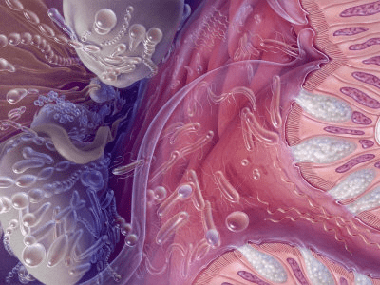General microbiology - viruses, bacteria, fungi >>>> Human microflora and its functions
Human microflora and its functions.

When it comes to the microflora of a healthy organism, it is important to note that a balance is needed between beneficial and opportunistic microflora. Many of the microorganisms, including conditionally pathogenic ones, appear in a person at birth, some settle in from the first days of life, others - after some time. Both beneficial and opportunistic microorganisms play their special role in the life of the entire microbiocenosis.
Obligant microflora (bifidobacteria, lactobacilli, peptostreptococci, colibacteria, eubacteria, fusobacteria, bacteroids, propionobacteria) is the main part of the microbiocenosis. It accounts for approximately 90% of the total number of microorganisms living with us. These are mainly anaerobic non-spore-forming saccharolytic (fermenting carbohydrates resulting in short-chain fatty acids) bacteria that occupy the surfaces (in the form of a biofilm) and the lumens of organs and their systems.
Each of the obligate bacteria has its own functions:
- Lactobacilli ferment lactose and produce lactic acid, which has an antiseptic effect and converts calcium entering the body with food into easily digestible calcium lactate; produce lysozyme, hydrogen peroxide, various bacteriocins.
- Bifidobacteria break down glucose, lactose, sucrose and mannitol to form acetic and lactic acids, and produce B vitamins.
- Lacto- and bifidobacteria produce lectins and similar substances and thereby stimulate cellular immunity (activation of lymphocytes). They also know how to synthesize antibiotic-like substances that affect the growth of conditionally pathogenic microflora and pathogens (listeria, clostridia, stepto- and staphylococci), suppress linolenic acid peroxidation, and together with enterococci, they also reduce the activity of angiotensin-converting enzyme (an enzyme that plays a large role in regulation of blood pressure).
- Bacteroids are involved in lipid metabolism, digestion, and break down carbohydrates.
- Propionobacteria produce organic acids and help synthesize vitamin B12.
- Eubacteria transform cholesterol into coprostanol (which is not absorbed by the intestines and is excreted from the body), deconjugates bile salts (initiates the biodegradation of harmful bile acids), in short, they fight cholesterol.
- Escherichia hydrolyze lactose, participate in the production of vitamin K and group B, in addition, they suppress the growth of strains of opportunistic and pathogenic bacteria (enterobacteria), take part in the regulation of cellular and humoral immunity.
- Peptostreptococci ferment carbohydrates, maintain the pH level of the large intestine, and participate in the enzymatic decomposition of milk proteins.
- Enterococci are involved in the fermentation of carbohydrates and the formation of lactic acid, are responsible for the fermentation process, reduce the level of acidity in the large intestine, and spur cellular and humoral factors of immunity.

Optional (often called conditionally pathogenic) serves as an addition and a kind of utilizer of the results of the work of useful microflora. Conditionally pathogenic microflora is quite diverse: these are bacteria staphylococci, streptococci, peptococci, clostridia, enterobacteria (Klebsiella, enterobacter, proteus, citrobacter, colibacteria (Escherichia coli), as well as Candida fungi. What role do pathogenic microorganisms play?
Optional microorganisms:
- Produce biologically active substances, thereby stimulating immunity,
- Participate in the synthesis of acetic and lactic acids (peptococci),
- Aerobic bacteria (Bacillus subtilis, B. pumilis, B. cereus) utilize oxygen, while creating a favorable environment for anaerobic bacteria (bifidobacteria, bacteroids, eubacteria, propionobacteria, Escherichia),
- They participate in the creation of colonization resistance (non-hemolytic staphylococci, streptococci, enterobacteria), that is, they restrain the attempts of potentially pathogenic microorganisms to colonize habitats on the mucous membranes of three systems (respiratory, digestive, urogenital), openly communicating with the external environment.
It is very important that the body maintains such a quantitative ratio between the obligatory and facultative microflora that would be optimal for both sides, does not disturb the microbiocenosis and does not cause such troubles for the human body as dysbiosis.

Read

Read



























